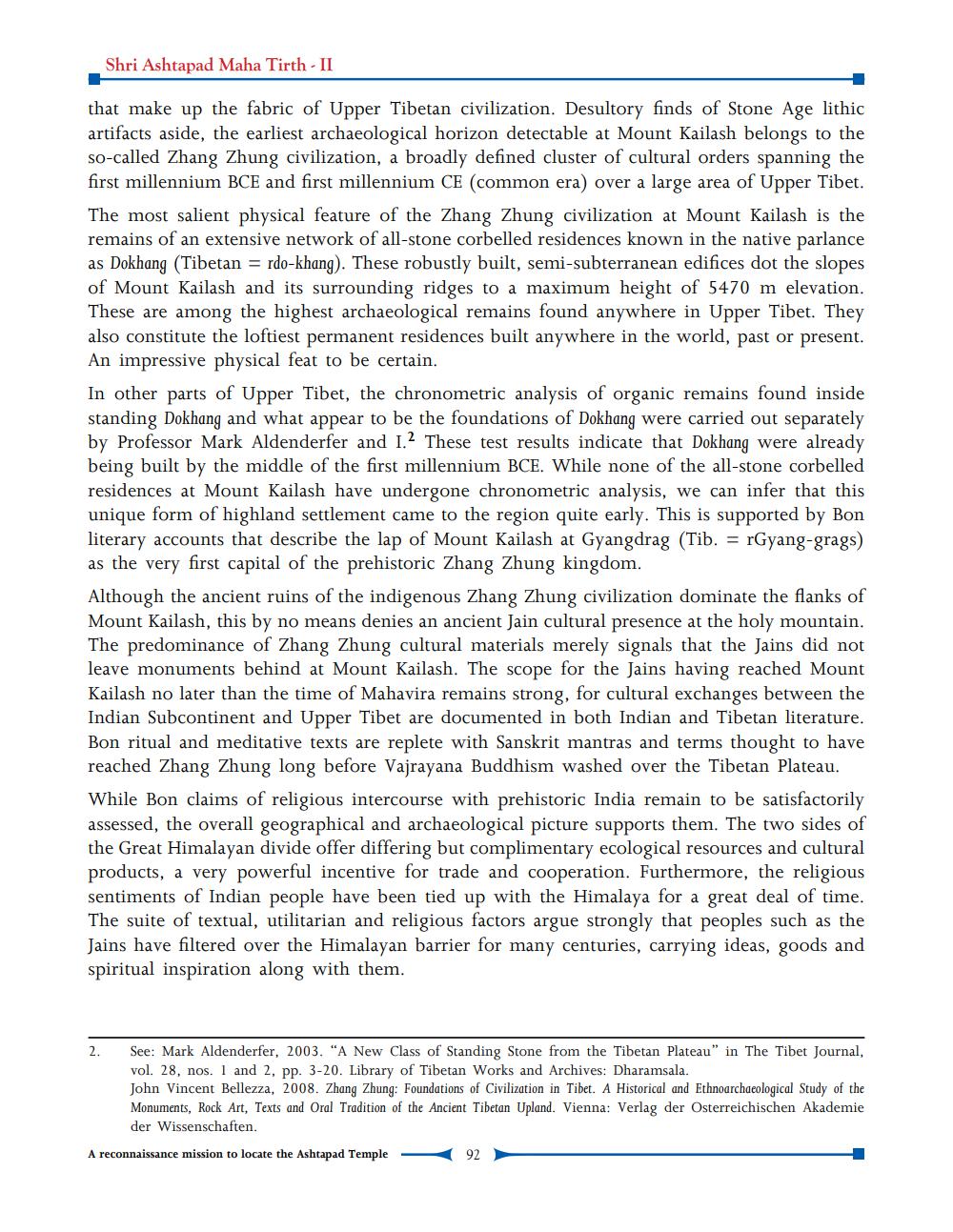________________
Shri Ashtapad Maha Tirth - II
that make up the fabric of Upper Tibetan civilization. Desultory finds of Stone Age lithic artifacts aside, the earliest archaeological horizon detectable at Mount Kailash belongs to the so-called Zhang Zhung civilization, a broadly defined cluster of cultural orders spanning the first millennium BCE and first millennium CE (common era) over a large area of Upper Tibet. The most salient physical feature of the Zhang Zhung civilization at Mount Kailash is the remains of an extensive network of all-stone corbelled residences known in the native parlance as Dokhang (Tibetan = rdo-khang). These robustly built, semi-subterranean edifices dot the slopes of Mount Kailash and its surrounding ridges to a maximum height of 5470 m elevation. These are among the highest archaeological remains found anywhere in Upper Tibet. They also constitute the loftiest permanent residences built anywhere in the world, past or present. An impressive physical feat to be certain. In other parts of Upper Tibet, the chronometric analysis of organic remains found inside standing Dokhang and what appear to be the foundations of Dokhang were carried out separately by Professor Mark Aldenderfer and 1.2 These test results indicate that Dokhang were already being built by the middle of the first millennium BCE. While none of the all-stone corbelled residences at Mount Kailash have undergone chronometric analysis, we can infer that this unique form of highland settlement came to the region quite early. This is supported by Bon literary accounts that describe the lap of Mount Kailash at Gyangdrag (Tib. = rGyang-grags) as the very first capital of the prehistoric Zhang Zhung kingdom. Although the ancient ruins of the indigenous Zhang Zhung civilization dominate the flanks of Mount Kailash, this by no means denies an ancient Jain cultural presence at the holy mountain. The predominance of Zhang Zhung cultural materials merely signals that the Jains did not leave monuments behind at Mount Kailash. The scope for the Jains having reached Mount Kailash no later than the time of Mahavira remains strong, for cultural exchanges between the Indian Subcontinent and Upper Tibet are documented in both Indian and Tibetan literature. Bon ritual and meditative texts are replete with Sanskrit mantras and terms thought to have reached Zhang Zhung long before Vajrayana Buddhism washed over the Tibetan Plateau. While Bon claims of religious intercourse with prehistoric India remain to be satisfactorily assessed, the overall geographical and archaeological picture supports them. The two sides of the Great Himalayan divide offer differing but complimentary ecological resources and cultural products, a very powerful incentive for trade and cooperation. Furthermore, the religious sentiments of Indian people have been tied up with the Himalaya for a great deal of time. The suite of textual, utilitarian and religious factors argue strongly that peoples such as the Jains have filtered over the Himalayan barrier for many centuries, carrying ideas, goods and spiritual inspiration along with them.
See: Mark Aldenderfer, 2003. "A New Class of Standing Stone from the Tibetan Plateau" in The Tibet Journal, vol. 28, nos. 1 and 2, pp. 3-20. Library of Tibetan Works and Archives: Dharamsala. John Vincent Bellezza, 2008. Zhang Zhung: Foundations of Civilization in Tibet. A Historical and Ethnoarchaeological Study of the Monuments, Rock Art, Texts and Oral Tradition of the Ancient Tibetan Upland. Vienna: Verlag der Osterreichischen Akademie der Wissenschaften.
A reconnaissance mission to locate the Ashtapad Temple
-
92




